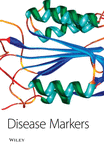Plasma Seprase and DPP4 Levels as Markers of Disease and Prognosis in Cancer
Abstract
Seprase (fibroblast activation protein α) has been examined as an invasion biomarker for various types of solid tumors. We studied whether plasma levels of seprase and homologous protease, DPP4 in cancer might serve as tumor biomarkers. We developed sensitive and specific Enzyme-Linked Immunosorbent Assays (ELISAs) to measure these proteases. In 747 plasma samples (from 139 healthy volunteers and 561 cancer patients), mean seprase and DPP4 levels were 0.51 ± 0.30 and 4.65 ± 6.37 μg/mL, respectively, and they were correlated with each other (R2 = 0.382). Plasma DPP4 and seprase levels were significantly lower in cancer patients compared with healthy subjects (4.38 versus 5.65 μg/mL, p < 0.001 for DPP4; 0.46 versus 0.66 μg/mL, p < 0.001 for seprase). Higher DPP4 was associated with better survival in all cancers combined (n = 346) as well as in head and neck malignancies (n = 38). Higher seprase was associated with better survival in all non-metastatic cancers combined (n = 151) as well as head and neck malignancies, but worse survival in colorectal cancers (n = 47). This study demonstrates that in contrast to the high expression in solid tumors, plasma concentrations of seprase and DPP4 are reduced and correlate inversely with survival in most types of cancer, suggesting that these circulating proteases represent useful tumor markers.




